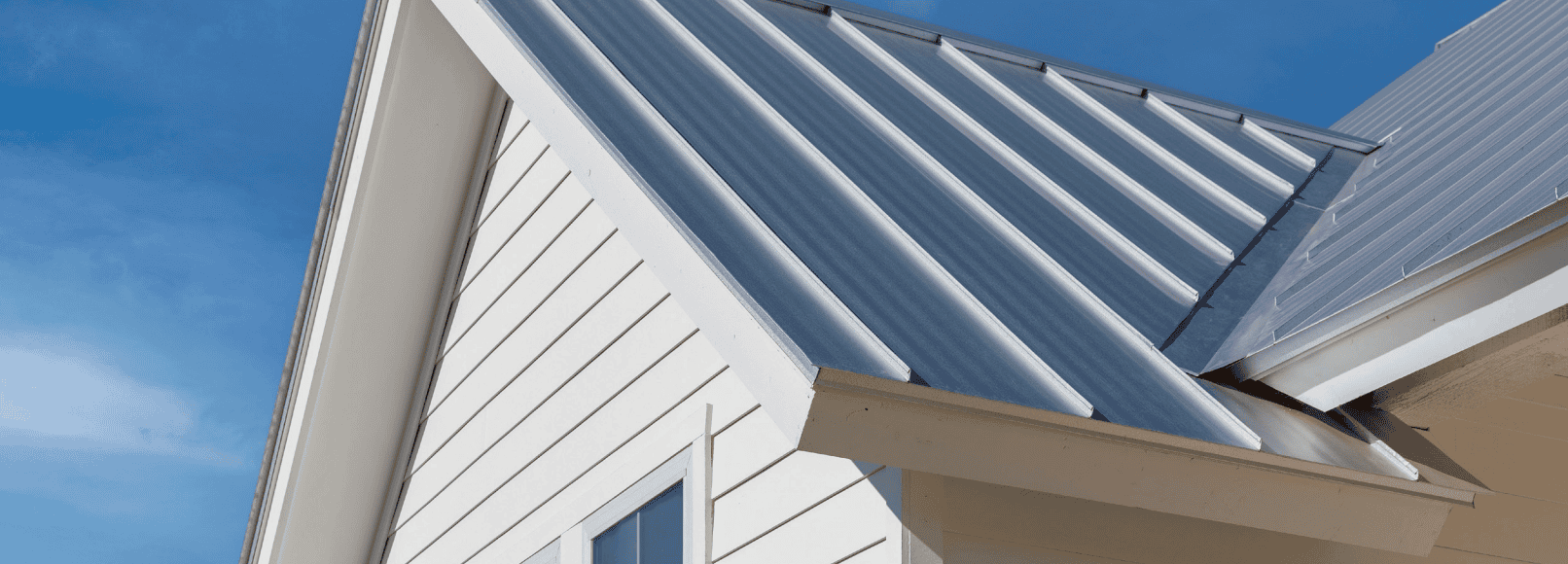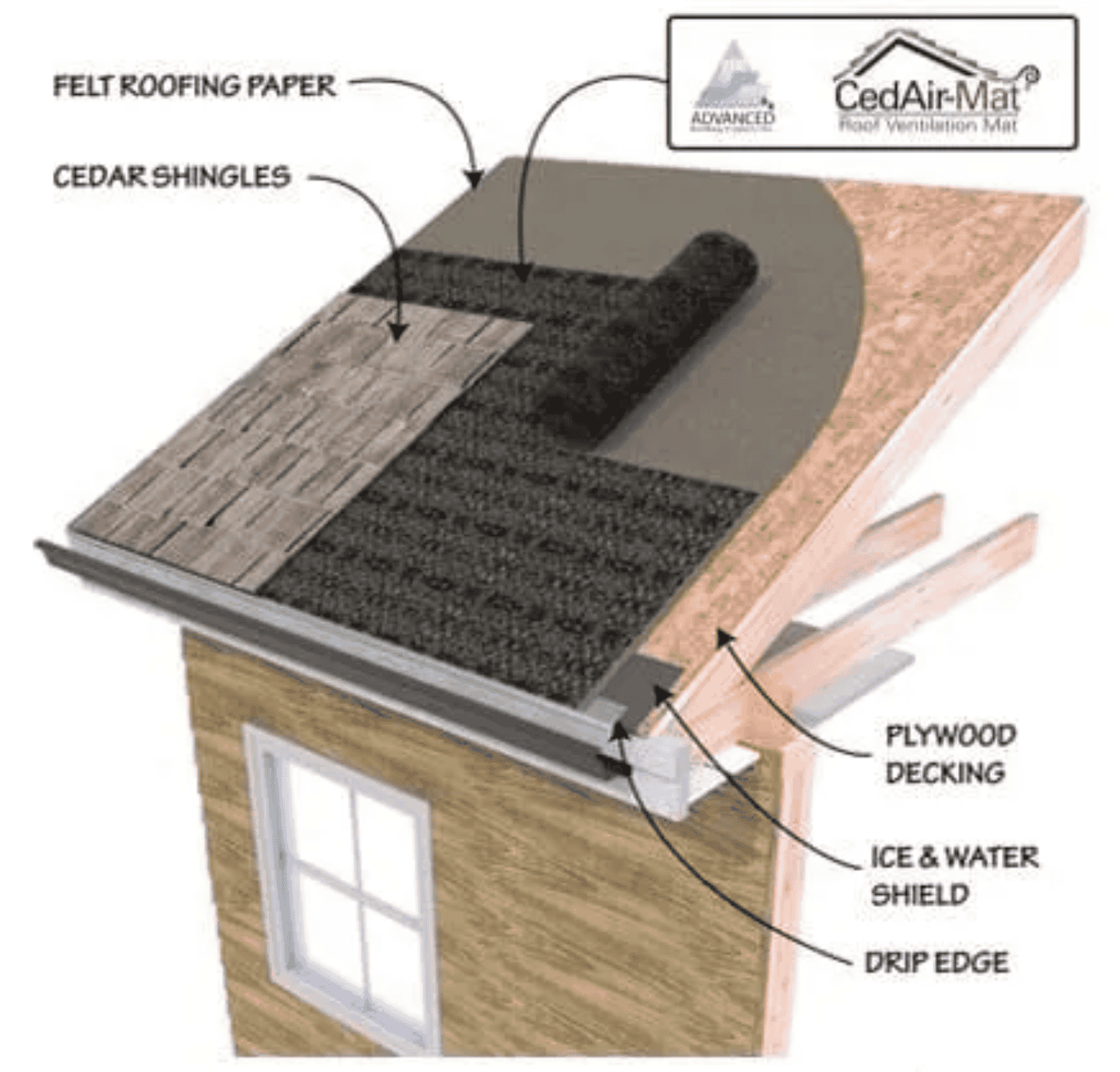Posted by Spycor Building on Nov 11th 2025

Do you see the dark streaks, the curled edges, or the soft spots starting to appear on your roof? This isn't just cosmetic damage; it’s the silent killer of your roofing system: trapped moisture. In modern construction and advanced roofing materials, neglecting the airspace beneath your shingles, shakes, panels, or tiles can lead to catastrophic failure, forcing premature, expensive replacements.
For property owners, builders, and architects dedicated to achieving decades of performance and maximum ROI from their roofing investment, the solution isn't just about what you put on top—it's about the precision-engineered cavity you create beneath.
This is where high-performance ventilation mats like R-Vent® and CedAir-Mat® become a non-negotiable component of a truly enduring roof system. These Advanced Building Products are not merely accessories; they are foundational, creating the critical, uninterrupted airspace required to manage moisture, regulate temperature, and genuinely extend the useful life of your roof, regardless of whether you’ve chosen classic cedar, contemporary metal, or durable tile.
| Product | Primary Use Case | Key Differentiator | Thickness |
| R-Vent® | Cedar, Metal, & Tile Roofing | Versatile Multi-Surface protection with 40% recycled content. | 9.16 mm |
| CedAir-Mat® | Cedar Roofing | Optimized for Cedar, focusing on all-directional airflow to combat rot. | 10 mm |
The Silent Killer: Why Ventilation is Non-
Negotiable for Your Roof System
Before diving into the specifics of these ventilation powerhouses, it is crucial to understand the engineering problem they solve. A roof assembly—the structure between the outside element and the sheathing—is inherently vulnerable to moisture.
The Physics of Roof Failure
- Condensation: In cold climates, warm, moist air from the building interior or the roofing material itself migrates outward. When it meets the cold underside of the panels or shingles, it condenses into liquid water.
- Solar Drive: During warm weather, residual moisture in the roofing material or the sheathing is heated by the sun and driven inward. If this moisture has no escape route, it remains trapped, leading to decay.
- Capillary Action: Without a clear drainage and ventilation path, water can be drawn upwards or sideways through the smallest gaps between roofing materials and the underlayment.
This persistent moisture leads to mold, mildew, sheathing rot, and, most visibly, warping and cupping of cedar shakes or the corrosion of metal panels. A damp environment destroys the integrity of the material, effectively cutting the expected lifespan of your roof in half.
The 90% Open Mesh Revolution
Both R-Vent® and CedAir-Mat® solve this problem by introducing a high-compression, durable 90% open mesh structure. This mesh creates a perfect, continuous airspace/cavity—a separation layer—that runs beneath the entire roofing surface. This airspace performs three critical functions:
- Drying Potential: It allows water vapor (condensation or solar drive moisture) to escape and allows fresh air to enter, creating a pressure-equalized cavity that promotes rapid drying in all directions.
- Thermal Break: It separates the hot (or cold) roofing surface from the sheathing, reducing heat transfer and mitigating the effects of thermal shock and condensation.
- Uninterrupted Drainage: It provides an instant and continuous path for any wind-driven rain or water intrusion to drain harmlessly away from the structure.
Introducing the Versatile All-Star: R-
Vent® Ventilation Mat
The R-Vent® system is the go-to solution for high-performance buildings utilizing multiple roofing materials. It is a testament to sustainable engineering, composed of a durable, yet lightweight, 9.16 mm mat that contains 40% recycled material. Its unique structure is built to handle the distinct challenges posed by three of the most popular, high-end roofing systems.
R-Vent® for Metal Roofing: The Sound & Moisture Solution
Metal roofing is lauded for its durability and modern aesthetic, but it presents two major challenges that R-Vent® definitively addresses:
- Noise Reduction: Metal roofs are notorious for transmitting rain and hail noise into the structure. The 9.16 mm 3D mesh of R-Vent® acts as an effective acoustic buffer, significantly reducing sound transmission and enhancing interior comfort.
- Corrosion Prevention: Trapped moisture beneath a standing seam or panel roof can lead to galvanic corrosion or unsightly pitting. By creating the 90% open ventilation cavity, R-Vent® ensures that any condensation that forms on the underside of the panel immediately drains and dries, preventing prolonged contact and corrosion.

R-Vent® for Tile Roofing: Drainage in Complexity
Concrete and clay tile roofs are heavy, highly durable, and often installed on battens, which can still lead to stagnant moisture pockets and difficulty managing complex drainage patterns. R-Vent® provides an indispensable layer:
- It prevents mortar or debris from clogging the drainage path.
- It ensures a continuous ventilation path that accelerates drying in the high-humidity environment often found beneath tiles.
R-Vent® for Cedar Roofing: All-Directional Airflow
While optimized for multiple materials, R-Vent®’s design is also highly effective for cedar, delivering the core benefit of all-directional airflow needed to combat the hygroscopic nature of wood. This shared functionality with CedAir-Mat® ensures that even the cedar components of a multi-material roof get the best possible ventilation.

Deep Dive: CedAir-Mat® — Maximizing
Exclusive Cedar Roof Longevity
For projects where cedar shakes and shingles are the primary—or only—focus, CedAir-Mat® provides a specialized edge. The mat’s namesake signals its precise engineering to combat the greatest threat to a cedar roof: premature rot and decay.
Cedar is organic and naturally beautiful, but it is highly susceptible to repeated wetting and slow drying cycles. When a traditional underlayment is installed directly under cedar, the shake acts like a sponge, drawing up and holding moisture from the sheathing.
The CedAir-Mat® Difference: 10mm of Targeted Protection
CedAir-Mat® is engineered at a robust 10 mm thickness, creating a slightly deeper separation cavity perfectly calibrated for the larger profile of cedar shakes. Its targeted function is to:
- Stop Capillary Action: The 10 mm 3D nylon mesh completely breaks the capillary connection between the moist cedar shakes and the underlying roof deck.
- Accelerate Drying: It facilitates all-directional airflow—not just up or down, but also laterally—ensuring that every part of the shake, especially the critical butt ends, can dry out rapidly after rain or dew. This process is the single most effective way to prevent cedar roof rot and the costly need for shake replacement.
- Maintain Aesthetic: By preventing swelling, cupping, and warping, CedAir-Mat® ensures the stunning, textured aesthetic of the cedar remains true for decades longer than non-ventilated installations.
In sensitive cedar roofs, this maximized ventilation capability translates directly into decades of extended service life, protecting the structural and monetary value of a premium roof installation.

The Strategic Advantage: Why Specify a
High-Performance Mat?
For high-end residential, commercial, and architectural projects, specifying R-Vent® or CedAir-Mat® is a decision based on performance metrics that directly impact your budget and long-term asset value.
1. Superior ROI and Lifespan Extension
The cost of a ventilation mat is negligible compared to the cost of a full roof replacement. By maximizing airflow and eliminating trapped moisture, these mats can double the lifespan of your roofing material. This ensures that the premium you paid for cedar, metal, or tile is realized over the maximum possible service life, generating the best possible Return on Investment.
2. Contributes to LEED Points
In the realm of sustainable construction, both R-Vent® and CedAir-Mat® contribute to achieving valuable LEED points. R-Vent® specifically uses 40% recycled material, aligning with material resource reduction goals, while both products contribute to thermal efficiency and moisture control, key aspects of durable building design.
3. Lightweight and Rapid Installation
Despite their robust performance, these mats are lightweight and designed for seamless integration. They bend and conform to any type of contoured roof surface and are easily handled and cut by installers, meaning the critical ventilation layer is installed quickly and correctly without adding unnecessary complexity or weight to the structure.
Order Now The Best High-Performance
Ventilation Mat To Secure Your Roof's
Future!
Drive continuous, life-extending airflow into your roof system today. Whether your project demands the multi-surface capability of R-Vent® or the specialized cedar protection of CedAir-Mat®, choose the proven performance that eliminates moisture, extends longevity, and protects your investment.
Order R-Vent® for Metal, Tile, & Cedar Projects
Order CedAir-Mat® for Dedicated Cedar Longevity
FAQ: Your Top Questions About Roof
Ventilation Mats Answered
What is a roof ventilation mat and how does it work?
A roof ventilation mat, such as R-Vent® or CedAir-Mat®, is a high-compression, 3D mesh product that is installed between the roofing material (shingles, panels, or tiles) and the structural roof sheathing. It functions by creating a 90% open cavity that allows for all-directional airflow and uninterrupted drainage. This prevents moisture from becoming trapped—eliminating condensation, solar drive moisture, and capillary action—which in turn prevents premature rot, warping, and corrosion.
Which roofing materials require ventilation mats?
While beneficial for all types, ventilation mats are especially critical for materials prone to moisture damage or those that need continuous airflow for long-term health. These include:
- Cedar Shakes and Shingles: To prevent rot, cupping, and swelling.
- Metal Panels: To reduce noise transmission and prevent corrosion from condensation on the panel underside.
- Tile Roofing: To facilitate fast drainage and drying beneath the complex, often non-vented, tile profiles.
What is the main difference between R-Vent® and CedAir-Mat®?
The primary difference lies in their application focus:
- R-Vent® is a multi-purpose mat designed for Cedar, Metal, and Tile roofing systems. It features a 9.16 mm thickness and contains 40% recycled content.
- CedAir-Mat® is specifically optimized for Cedar Roofing. It has a slightly deeper 10 mm profile, calibrated to maximize the continuous airflow necessary to combat moisture absorption and decay in cedar shakes and shingles.
Can a ventilation mat reduce noise on a metal roof?
Yes, R-Vent® is highly effective at reducing sound transmission on metal roofs. The 9.16 mm 3D mesh layer acts as an acoustic dampener between the metal panels and the roof deck, significantly reducing the noise generated by rain or hail.
Does using a ventilation mat affect my roof warranty?
No. High-performance ventilation mats like R-Vent® and CedAir-Mat® are designed to be integrated into premium roofing systems. Using these products to manage moisture and extend the lifespan of the roofing material can actually help a system meet the conditions necessary to sustain a long-term manufacturer warranty against material failure due to moisture. Always check the specific roofing manufacturer's installation guidelines.
How do R-Vent® and CedAir-Mat® contribute to LEED points?
By promoting building durability, reducing maintenance, and contributing to the overall thermal and moisture management of the building envelope, both mats support LEED certification goals. R-Vent® specifically helps achieve points under the Materials and Resources category due to its certified 40% recycled content.



